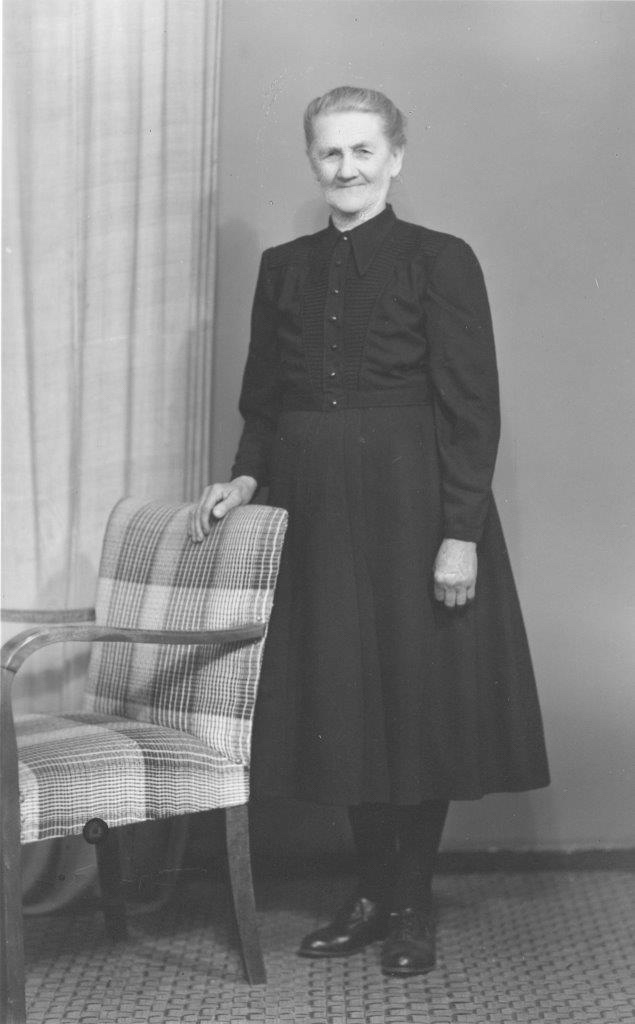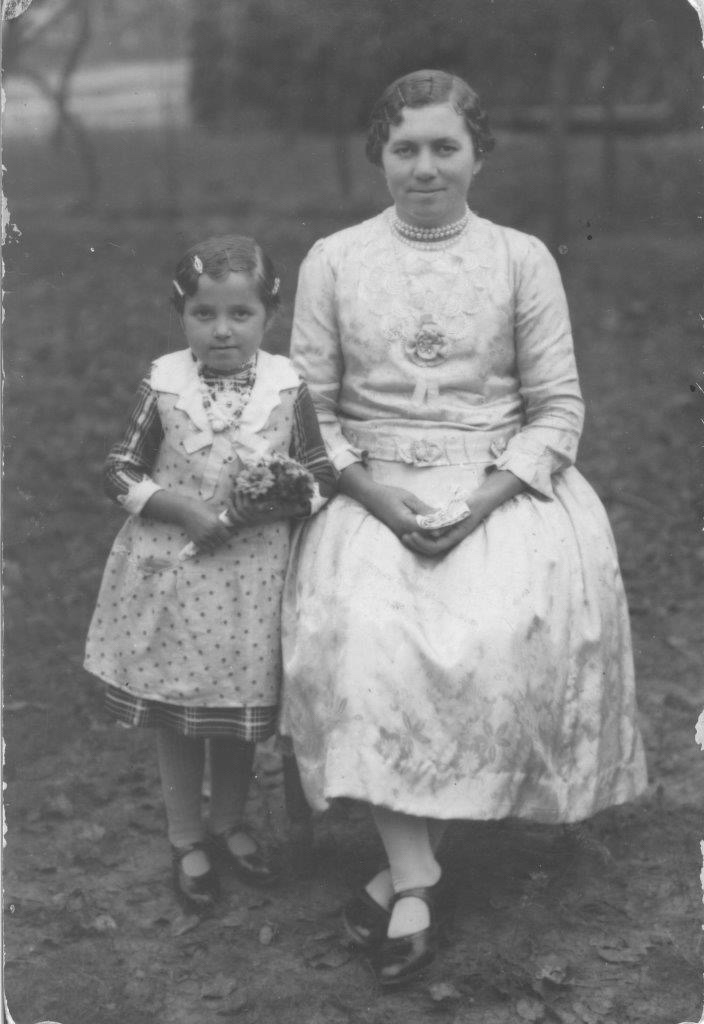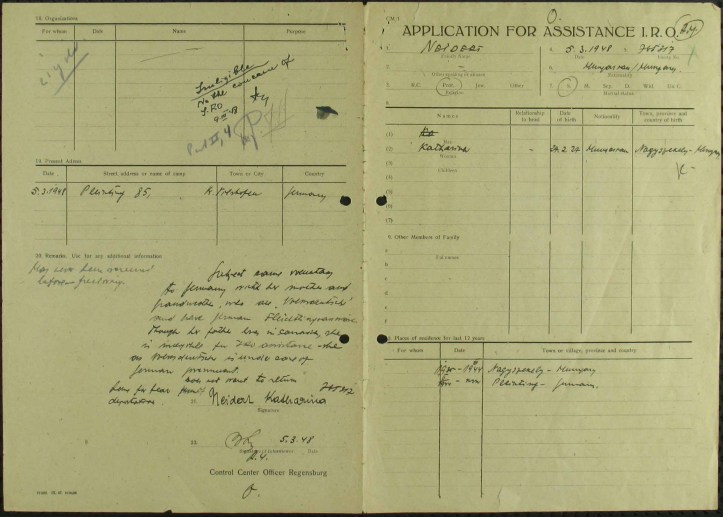Both my parents were ethnic German, something that always confused me as a child because I knew that my father’s family had lived in Poland for many generations, and my mother’s in Hungary…. so how were they Germans?
In history and geography classes in high school, I came to understand that Poland as I knew it had not always existed, and that when my paternal ancestors settled there it was Prussian. Nothing I learned explained why mom was German instead of Hungarian though. Still, all the stories she and my grandmother told were of a town with a German name – Gross Säckel – and an almost 100% German population, most of whom were somehow related to us.
It wasn’t until after mom died that I found a website called Swabian Trek, dedicated to the history of Swabians from the Danube River and their settlement in Nagyszekely Hungary from the 18th century through to their expulsion in 1948 by the Russians (Nagy = Gross = Large; Szekel = Säckel phonetically = bag or seat; it was the county seat of Tolna). The website was a revelation, answering SO many questions. Apparently my mom’s family had been refugees once before, in the mid 1700’s, when Protestants like them were made unwelcome in Catholic Swabia. It also suddenly “clicked” as to why my mom’s male cousins reverted to the Swabian dialect after a few beers and shots (beer followed by a brandy chaser – chug and repeat – being the libation of choice among the men). There in black and white on a web page were dozens of familiar family names; most of them had been represented in our living room at one time or another.
So, I’m “German” on both sides of the family, but I’m going to begin with my mom’s side. I’ll preface it with the fact that this side of the family was, for a couple of generations, mostly through necessity, a matriarchy: hence it is the story of Katharinas. There were no stories told (in my hearing, anyway) about the men. Maybe they were reserved to be told to their sons, but there were no sons.
In 1700’s Hungary, the German families were originally serfs, but by the mid 1800’s they were independent farmers and landholders. My mother’s family had a vineyard, inherited through the maternal side of the family, but I never heard of them making wine – only growing the grapes. They must have done fairly well, because my great-grandparents, Katharina (Braubach) and Heinrich Schott, travelled to the United States in 1904. There was some thought that they might settle there – until news arrived that my great-grandfather’s younger brother was planning to take over the vineyards. The couple booked passage back to Hungary and stayed there to reclaim the inheritance and run the vineyard. Until I was 8 years old, my great-grandmother lived with us – in fact, she’s the main reason I spoke German first, since she spoke no English except the one mispronounced expression she retained from her time in America: “goombye Chicago”.

My maternal grandmother was born in the family home on January 24, 1906 and christened Katharina just like her mother. Despite the fact that her parents both came from fairly large families, she was their only child.
My grandmother never spoke about her childhood, so I’d have to assume it was uneventful – and yet she would have been a young teenager during the first world war. I know that her father, along with all the other able-bodied men in the town, was gone during those years; the first of many times that the vineyard was left in the hands of the “womenfolk”. My great-grandmother was a stern presence, and my own mother viewed her grandmother as critical and somewhat scary, so perhaps taking charge of the vineyards workers and finances took its toll. I can’t say that I ever witnessed much outward affection between my grandmother and great-grandmother, but there was no obvious animosity either – I think my grandmother felt that she owed her mother a debt for her role in raising my mom. By all accounts, my great-grandfather was the gentle presence in their relationship. He came back from the war unharmed – due, he said, to the fact God had watched over him because he refused to kill any of “the enemy”. While my mother was scared of her grandmother, she adored him. He died in 1934, when she was just 7 years old, and she was inconsolable. She often talked about the days after his death, while he was laid out in their home as was the custom, and how she sat perched on the coffin and stroked his hair just the way he had always allowed her to do when he was alive. In the last few years before her own death, mom often said that her grandfather was the only man who had ever really loved her.
I don’t know how my grandmother and my grandfather, Johann Neidert, met, but Nagyszekely was a small town where everyone went to the same school, so it’s inevitable that their paths would have crossed. They married in 1924, aged 18 and 19. That was fairly young for their community, but I think my grandmother was pregnant with their first child, who she miscarried – a fact put down to how tightly she was corsetting herself to prevent her pregnancy from showing. I later realized how silly that was of her, since marriage and birth records in the town show that a majority of first children were born far less than 9 months after their parents’ marriages. My mom, the third Katharina in a row, was born 3 years later on February 27, 1927, a tiny baby about a month premature. My grandmother always said they fed my mom thin cream of wheat and cabbage broth since she didn’t nurse well, but…. really? The only thing I know for sure is that my grandmother assigned cabbage almost supernatural qualities, whether in her soup, strudel, cabbage rolls, or mixed with potatoes or egg noodles into a dish to nourish everyone from children to young mothers to elderly relatives.
Mom was given a delicate pair of pearl and turquoise earrings as a christening gift, and my grandmother pierced her baby’s ears with a sterilized sewing needle and a sliver of ice off one of the blocks in the icehouse. As an adult, mom was never without earrings, and I could hardly wait to have my own ears pierced (which I was finally allowed to have done – by our family doctor! – for my tenth birthday).


In 1929, frustrated with being dependent on a vineyard tied to his wife’s family, my grandfather set out for North America to claim his share of riches in Canada, a place where he’d heard that the streets were paved with gold. “The plan” was to get rich quickly and then send for his wife and infant daughter, but … 1929. His timing could not have been worse.
Instead of sending for his family, or returning home “in disgrace”, my grandfather simply made himself disappear. No letters home, which also meant no money sent home, but no death certificate either – just no communication at all.
My mother and grandmother continued to live with my great-grandparents. As long as my great-grandfather was there running the vineyard, everything was fine. My grandfather was not the only absent spouse; some had died during the war, and others like my grandfather were in Canada or the U.S. My mom was spoiled by her grandfather, and managed to be “cute” even when she was being mischievous. My favourite story involved a furry caterpillar. Mom apparently found one in the vineyard and was playing with it. My grandmother wanted her to get rid of it, but mom resisted. When grandma reached to take it away from her, mom “protected” it… by popping it into her mouth! Apparently only her grandfather thought it was adorable. As a child I loved that story, and fuzzy caterpillars, although I would never have put one in my mouth.
After my great-grandfather’s death, the house contained only women: my 56 year old great-grandmother, 28 year old grandmother, and 7 year old mom. The vineyard workers must have thought they’d have free reign, and I don’t honestly know how things were kept running, except that my great-grandmother was strong-willed enough to apparently scare more than just my mom, and there were men in town with their eye on grandma who were willing to act as foremen. My mom remembered that grandma had a “husband”, although two years later when 7 years had elapsed since my grandfather’s “disappearance” he was declared legally dead, and grandma married someone else, a local farmer with land of his own. Mom never mentioned him living with them, or that she lived on his farm, so it’s possible this is when mom started her first period of being raised by her grandmother.

By the time World War 2 broke out, my grandmother was no longer married. I never overheard anyone talk about exactly what happened, except for a veiled comment from a relative that her husband was not interested in raising another man’s child, and my grandmother would not forsake my mom.

Unfortunately, without a husband to oversee the vineyard, a foreman was needed, which meant there had to be money to pay them. My grandmother was too old to go out to work, and my mother too young, so my grandmother left them both again to work as a maid in a wealthy residence in Budapest, which was about 140 km away.
From all accounts, my mom hated living with her grandmother. The “old woman” was strict and critical. Once my mom hit puberty, things got even more tense. Mom was considered quite pretty, and my great-grandmother was sure she’d become a “Schlampe” (trollop). Mom’s two great pleasures were school, and the pretty hand-me-down clothes my grandmother would send to her from the city. Mom always claimed that wearing the fancy shoes grandma sent, which were a size too small for her feet (but “SOOOOO beautiful”), were the reason she developed such terrible bunions. It’s true that the shoes in the picture of her at 14 look smaller than the ones she wore in the picture of her at 12.

In 1942, at 15 years old and having finished school, mom began working as a kindergarten teacher – the equivalent of today’s ECE’s in daycare. That’s the job she was coming home from in 1944 on the day the group of girls she was with was chased down the street by a low-flying bomber. Every time she told that story, her eyes would fill with remembered terror.

Nagyszekely was a strange place to be during the war. Because it was a “German” town, when the Nazis occupied Hungary in 1944 they investigated everyone’s genealogy all the way back to the late 1600’s; “Germans” were left alone (the women) or conscripted (the men), but anyone they determined to be “gypsy” was evicted from the town. Fortunately, there were no men in mom’s household who would have had to decide between enlisting or running. Then in 1945 when the Russians expelled the German armies, all the ethnically German residents were “encouraged” to get out of the country.

I don’t have exact dates as to when the three Katharinas left Nagyszekely for Germany. EDIT: After publishing this blog, a contact at the Croatian National Home in Hamilton, Ontario (where my parents’ wedding reception was held) found an on-line resource that had the original documentation fir my mother’s claim for refugee assistance, showing their arrival in Vilshofen, Bavaria in 1944 (below).


What I do know is that they were one of the last families among their group of relations to leave; most of the relatives that I later got to know had recognized the signs of what was to come and emigrated voluntarily years earlier. Of those Germans who stayed on to live under Communist rule, many had married Hungarians and moved out of the “German” town.
I do know that my grandmother had lost her job in Budapest (Germans were no longer welcome there) and rejoined her mother and daughter in Nagyszekely , so the three generations of Katharinas travelled together.
Their arrival in Germany and eventual settlement in Canada is a separate set of stories.
My mom’s side of the family all were from Nagyszékely, they were kicked out during the war and immigrated to Canada. As far as I can trace back, my great grand mother was Neidert before she married. She was Katharina Neidert and married Fillip Schilling. They had one child Katharina, she married Janos Tippel, and they eventually changed their last name I think before they came to Canada, to Tolnai. They came to Ontario Canada with quite a few others from the same town, and many settled near the Delhi ont area and were farmers.
LikeLiked by 1 person
We knew them!! I can remember as a young child visiting the Tippel/Tolnai family on their farm. There is definitely a family connection on the Neidert side!
LikeLike
unfortunately they passed away, as most of the original people moved to the area. It interestingbto see all the photos of the Hungarian town. Maybe one day I’ll get a chance to visit. My dad was from Germany, so it would ge nice to see it all in one trip. Not sure I could find the exact property or see their old vineyard and press house. The property details in the town that I’ve seen so far don’t have the info.
LikeLike
My grandmother went back to visit in the 1970s, and the house was still occupied, although the vineyards were long gone. Ted and I debated trying to find it based on Google map pictures when we visited Budapest, but we were on a tour and it was too far away for us to do in our free time.
My dad was from a German settlement in Poland, now almost completely gone except for a cemetery, but just yesterday I heard from a Polish history buff who knew more than I did! It seems it was family day for the blog!
LikeLike
My maiden name was Neidert. The family lived in Nagyszekely up until the late 1870’s. at which time they moved to Budapest. My Ggranfather Kristof (Anna need Misek); GGgreat Fulop and kata (nee nagel); other ancestors: Werner/Phillip/ Heinrich/ Johann Neidert; Anna Margaret’s Schneider, Netta Weghman, Magdalena Koch, Anna Maria Ackerman.
To the best of my knowledge, my grandfather, Gyula, was the only Neidert to emigrate to America (specifically Detroit, MI).
I would love to connect with any possible “family” and explore how we may be related.
Amyiverson@msn.com
LikeLiked by 1 person
I’ve emailed you!
LikeLike
According to information my mother gathered regarding her ancestry, we have relatives from Nagyszekebly that immigrated from Germany. According to her we have a Johann Neidert in our family but she didn’t know much about him. My mother’s maiden name was Neidert and she and her family were from Rochester NY. loved your family story, maybe we are related 😃
LikeLike
We probably are related! Each Neidert family seemed to have a John/Johann, so if our grandfathers were cousins, we’d be third cousins!
LikeLike
It feels like looking back into my families history! I have a picture of my dad in his coffin in our living room. Mom was holding me and others were in the picture.
Cabbage – my grandmother made cabbage strudel (yum) and kraut frekerle. Squares of dough with fried cabbage. (Again – yum)
>
LikeLike